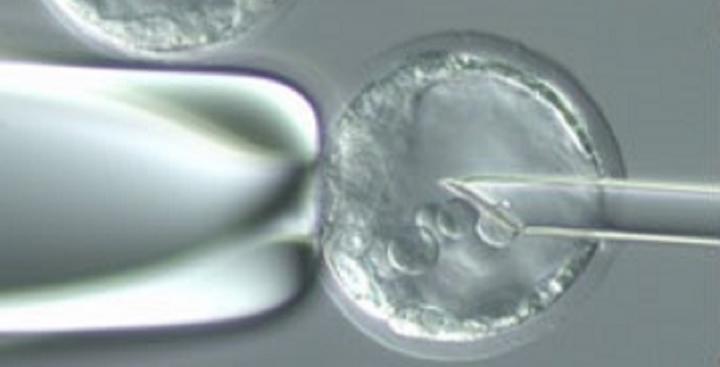ES Cell Microinjection (Mice)
Information on targeted Embryonic Stem (ES) cell microinjection to generate transgenic mice

One method of generating transgenic mice involves the microinjection of targeted ES cells into blastocyst embryos. The donor embryo is from a strain different in coat color to that of the ES cell strain. During embryo development, the introduced ES cells integrate within the recipient embryo's inner cell mass to form a new chimeric embryo. Once born, chimeric mice can be identified by their coat color.
A mouse with a high percentage coat color of the ES cell strain is called a “high percentage chimera”. However, coat color is not indicative of the ES cell’s integration within the resulting mouse’s germ cells and subsequent transmission of the targeted allele to its progeny. Male chimeras therefore need to be bred to a wild type female to determine germ-line transmission (GLT). Coat color of the progeny will determine if GLT has been successful.
The global mouse knockout program has made available conditional and knockout alleles for thousands of genes on a mail-order basis (see useful links). CTC can arrange for commercially purchased or custom-made ES cells to be injected into blastocyst-stage donor embryos. CTC can also perform ES cell injection into 8-cell stage embryos using an Xyclone laser.
Researcher’s responsibilities during process:
- Order/generate and expand targeted ES cells (ensuring to check quality controls performed by the company if ordering from a commercial source).
- At least 2 independently targeted clones per line are recommended.
- Arrange an MTA if ordering targeted ES cells from a commercial source.
- Establish a screening protocol to identify transgenic mice either by PCR or Southern blot.
- Ensure your ES cells are mycoplasma-free and have a correct chromosome count.
- Complete the "Request to Produce Transgenics Form" (see below) and return it to the CTC manager.
- Complete the "ES Cell Submission Form" (see below) and return it to the Transgenic Technician.
- Bring targeted ES cells to the designated facility no later than 10am on the day of injection. We also can arrange for your ES cells to be picked up on the injection day from any institute within the University.
- Provide feedback regarding germ-line transmission to CTC (please see below).
CTC’s responsibilities during process:
- CTC will seek approval of the Transgenic PPL holder as well as the NVS for generating the new line.
- CTC will provide vasectomized and stud males and organise the purchase of donor female mice on behalf of the researcher.
- CTC staff will communicate with the researcher and arrange suitable dates for injection sessions.
- If necessary, CTC will organise pick-up of the ES cells on the injection day from the researcher's institute.
- CTC staff will inject donor blastocysts and transfer embryos to pseudopregnant recipients.
- The generation of chimeric mice is highly dependent on the condition of the ES cells. We cannot guarantee transmission of the mutation through the germ line.

